Between the summer of 2011 and February 2012, the unemployment rate experienced its largest half-year drop since the huge recovery that had been taking place in 1984. It was a very welcome sign that the US economy may have avoided becoming entangled in the global funding messes of 2011. Caught flat-footed, as always, Ben Bernanke’s Fed had ended QE2 at the end of June that year on what was believed to be a high note only to begin anew with Operation Twist not even three months later.
Those fateful weeks in between during August 2011, the discussions taking place at the FOMC sound entirely too familiar to us observing similar circumstances 2019-20. For one:
MR. SACK. You could argue for not pulling the trigger immediately in order to see if markets calm down and the repo rates return back into the range of 0 to 25. I guess I was curious if the Committee has decided that it isn’t concerned about repo rates, if it has decided that it is concerned about elevated repo rates but wants to allow more time to see if they come back down, or if it wants to go ahead and lean toward some kind of an action in that direction.
Except for the reference to the 0 to 25 range in force at that time, Open Market Desk Manager Brian Sack’s statement wouldn’t have seemed the least bit out of place during the middle week of September 2019. Nor would another highly curious question, in light of $1.6 trillion in QE-related bank reserves, from the FRB’s director of its Division of Monetary Affairs, Mr. William English.
MR. ENGLISH. With the funds rate up only a few basis points over the same period, a natural question is whether the repo rate has idiosyncratically diverged from the overall constellation of money market rates or whether it is a symptom of broad dislocations in money markets that could interfere with the transmission of the Committee’s intended monetary policy stance.
It is the thinking behind that last part which in its latest form had undoubtedly guided Jay Powell in September to his various non-repo repo interventions. The not-QE QE, too.
But, as I started out, the economy was looking good as 2011 became 2012. To make sure, in addition to Operation Twist the ECB had launched the “massive” “flood” of “liquidity” that was two LTRO operations. Like today, the financial media then had told you to believe everyone around the world was highly enthused by so much “stimulus.”
Then something happened. Not only did economic growth all around the world suddenly stall, right around March, to start off April 2012 a plunge in global interest rates; a second plunge, actually, piling on top of the first one, also “unexpected”, which had taken place earlier on during the year before leading up to August 2011’s second global crisis (dollar shortage).
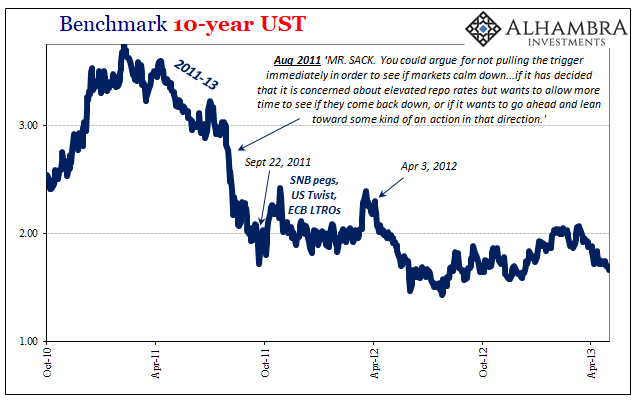
Near the end of that same year, 2012, Fed Governor Jeremy Stein (one of the few paying attention) would give a speech in Germany talking about, surprise, surprise, “dollar funding and global banks.” That was his actual title. At a time when everyone had said these were just “euro problems” at least one policymaker acknowledged how there was more to it.
What Stein had surmised was European banks beset by questions of creditworthiness (more so liquidity concerns after having been repo-ing PIIGS debt at the worst time) found themselves by the middle of 2011 with an enormous funding mismatch neither they nor anyone else could easily handle. It had been standard practice throughout the middle 2000’s, if not beginning earlier, for them to take up a leading position in global (meaning offshore) US$ credit (and money) markets.
This was in addition to a massive credit expansion inside the euro system. But while this latter perfectly normal domestic activity had been funded (largely) by insured euro-denominated deposits, the old textbook fractional reserve lending approach, their dollar-based activities were not. These instead had been funded wholesale in offshore markets like repo and FX.
If dollar markets became fickle, and they had, twice by then, what recourse do European banks have?
Jeremy Stein:
So we might expect such a shock to induce the bank to shift its funding away from the U.S. wholesale market and toward the European deposit market. But what are the consequences of this adjustment, both for the geographic distribution of its lending and for the functioning of foreign exchange (FX) swap markets?
Note that if the bank wants to maintain the volume of its dollar-based lending, it will have to tap its insured deposit base to raise more euros and then swap these euros into dollars using the FX swap market. However, if the induced funding realignment is big enough, and if arbitrageurs have limited capacity to take the other side of the trade, this large swap demand can cause a breakdown in the usual covered-interest-parity (CIP) relationship–a breakdown of the sort that we have seen during times of extreme market stress. In this case, the direction of the deviation would be such that the cost of synthetic dollar borrowing–in other words, euro borrowing combined with an FX swap–would go up and would approach that of the now-elevated cost of funding directly in the wholesale dollar market.
TL/DR: unless the FX market is able to pick up the slack, FX rates (basis) will eventually mirror those wild numbers in wholesale markets like repo. But was the problem actually European banks’ creditworthiness? Or is it the market being unable to absorb what really wasn’t that big of a shock (fragility)?
You won’t be surprised to learn that officials always and everywhere assume it was the former; European institutions’ creditworthiness, as the ECB began in 2011 (really 2010) to take as many PIIGS bonds off the hands of its banks as it possibly could. Voila, Draghi promised, European banks would be fixed and everything could get back to its presumed post-2008 recovery.
In a lot of ways, 2011 was treated seriously but not seriously enough. Always focused on the surface, more immediate symptoms rather than the much larger issue which was decidedly frightening. A systemic break would present an entirely different set of problems that, because this dollar system was global, may not be able to overcome so much loss of capacity as had been indicated by, well, everything up until that time.
Twice.
Repo was definitely a big part of it, as we can see in what I wrote yesterday going through the TIC figures related to it. In case you don’t immediately spot it on the chart below, notice what happened in the same “resales” during that very crucial month of April 2012:
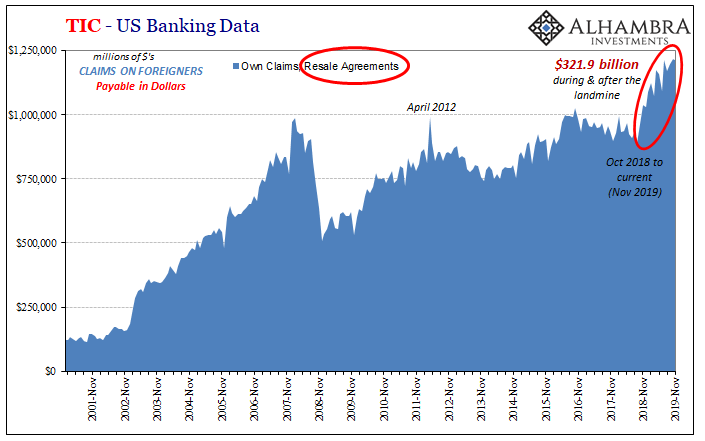
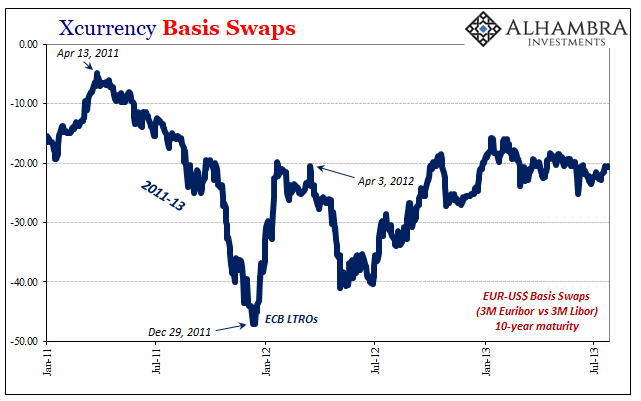
Right then, the US unemployment rate said the US economy was in a good maybe great place and many were expecting Europe to have bottomed out, but each took a turn for the worse as funding problems re-emerged all throughout a fragile global system. Bond yields fell and the FX basis dropped (more negative than it already had been; for a narrative explanation as to why a negative basis is equivalent to a dollar shortage, you can read up on it here).
Europe dropped into outright recession while the US came close. In other places, like China, importantly, it was the beginning of the end.
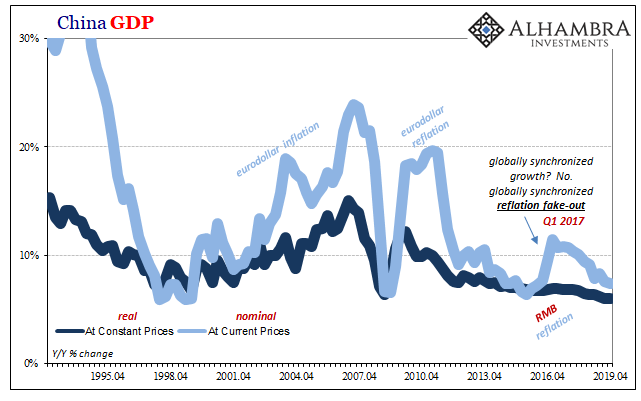
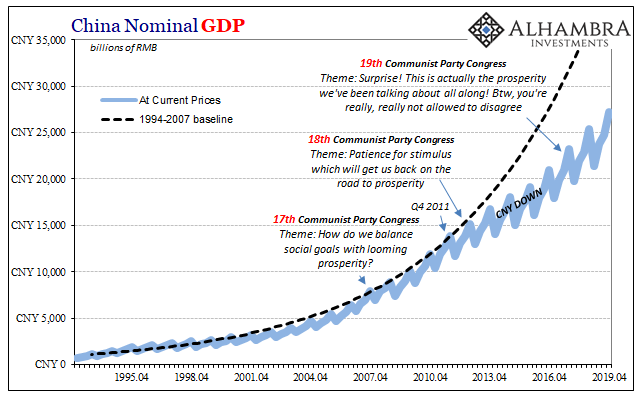
Falling basis, falling yields, and repo problems. Central banks come in and do a bunch of stuff, everyone says its good and the economy is strong, and then “out of nowhere” it happens again a second time in less than a year. A renewal of a situation supposedly well in hand despite so much “bold” central bank intervention.
Ancient history, right?

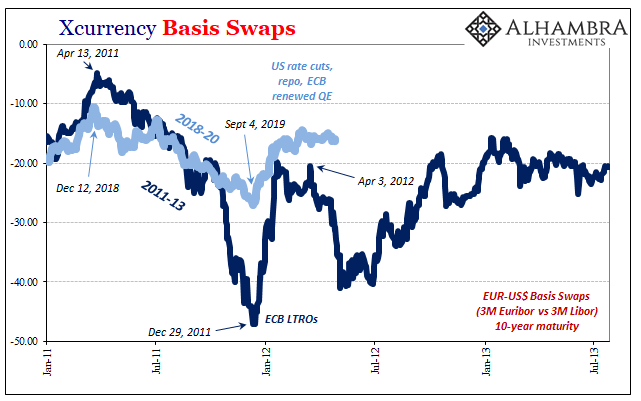
By these charts, I’m not suggesting that the world is repeating 2011 and 2012. Nothing ever truly repeats, not exactly anyway. What I’m saying is that it can so often look that way because the same underlying issues remain unresolved – even though 2011 was almost a decade ago!
Had it really been European banks’ creditworthiness, or was it a systemic breakdown?
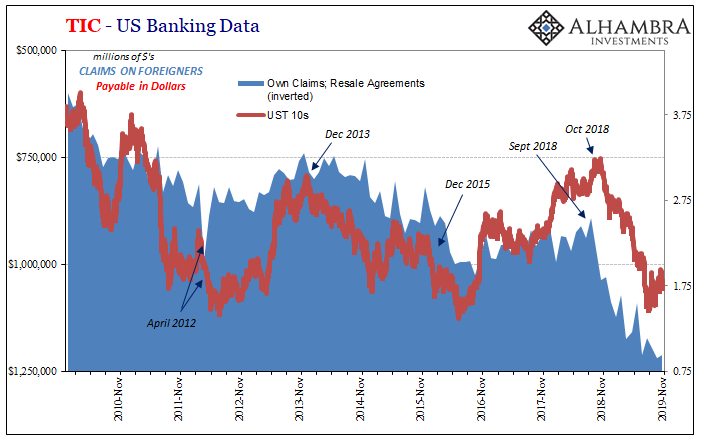
The latter. We are still observing basically the same things which then manifest into the same sorts of problems. And those include, much like early 2012, US economic susceptibility to global dollar conditions no matter what the unemployment rate says and does.
That’s why, on some distant level, Jeremy Stein’s little appreciated speech is connected directly to QE3 which Ben Bernanke felt had become necessary by September 2012 despite the “strong” labor market numbers. In other words, given what Stein would later say about the mechanics, the Fed continued to act as if this was all someone else’s problem. Thus, not a fix to the actual problem, instead a third (and fourth) QE as “insurance” against the potential fallout.
Though I wrote it this way on purpose, you have to admit how you can hear Jay Powell in that sentence.
Paraphrasing Santayana, those who cannot understand the past are condemning all the rest of us to repeat it. Like that earlier period, Euro$ #2, we’ve already seen the first half of Euro$ #4 to this point. Will there be a second half? What will that mean, particularly if the first half of #4 has been worse than most if not all of #2?
Strong labor market indeed.


Stay In Touch